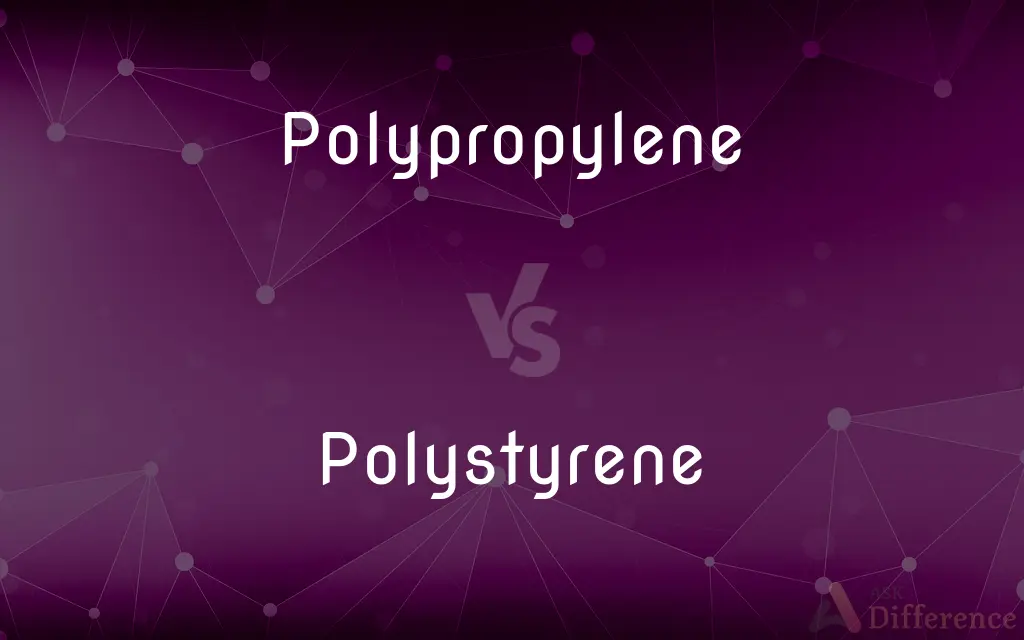Polypropylene vs. Polystyrene — What's the Difference?
Edited by Tayyaba Rehman — By Fiza Rafique — Updated on April 18, 2024
Polypropylene is favored for its flexibility and resistance to chemicals, while polystyrene is chosen for its rigidity and ease of molding.

Difference Between Polypropylene and Polystyrene
Table of Contents
ADVERTISEMENT
Key Differences
Polypropylene, a polymer known for its resistance to chemicals, heat, and fatigue, is widely used in containers and automotive parts. On the other hand, polystyrene is appreciated for its rigidity and insulating properties, making it ideal for disposable cutlery and packaging materials. Both materials are plastics, but their chemical structures and physical properties differ significantly.
Polypropylene is characterized by its semi-crystalline nature, which contributes to its durability and flexibility. In contrast, polystyrene is typically more brittle and less flexible, often used in situations where stiffness is more important than resilience. These characteristics influence their respective applications in various industries.
Regarding environmental impact, polypropylene is often lauded for its higher melting point, making it more suitable for applications requiring repeated sterilization. Polystyrene, however, is difficult to recycle and has been a focus of environmental concerns due to its long degradation time and impact on wildlife.
Polypropylene can often be found in reusable items due to its toughness and lower risk of leaching chemicals. Meanwhile, polystyrene, due to its potential health risks from styrene leaching, is commonly used in single-use products.
The production costs of polypropylene are generally lower compared to polystyrene because of its less complex manufacturing process. This makes polypropylene a more economically viable option for a wide range of products, whereas the cost-effectiveness of polystyrene is restricted to specific applications where its unique properties are indispensable.
ADVERTISEMENT
Comparison Chart
Flexibility
High flexibility
Brittle and rigid
Chemical Resistance
Excellent resistance to chemicals and heat
Susceptible to certain chemicals and heat
Environmental Impact
More recyclable, higher melting point
Less recyclable, environmental concerns
Usage
Reusable containers, automotive parts
Disposable cutlery, packaging materials
Cost
Generally lower production costs
Higher production costs for specific uses
Compare with Definitions
Polypropylene
It has a high melting point, making it suitable for reusable products.
Polypropylene is used in dishwasher-safe containers.
Polystyrene
Polystyrene is less environmentally friendly due to its slow degradation rate.
Environmental groups often campaign for reduced use of polystyrene in packaging.
Polypropylene
A thermoplastic polymer used in a wide variety of applications.
Polypropylene is often used in automotive and industrial applications due to its durability.
Polystyrene
It is known for its ability to be easily molded and extruded.
Polystyrene frames are popular for their smooth finishing and light weight.
Polypropylene
It is recyclable under certain conditions and is considered environmentally friendlier.
Polypropylene is preferred for eco-friendly packaging solutions.
Polystyrene
It can be clear or colored, depending on its intended use.
Clear polystyrene is used for CD cases.
Polypropylene
Known for its resistance to chemicals, heat, and mechanical fatigue.
Polypropylene containers are ideal for storing laboratory chemicals.
Polystyrene
Frequently used in the production of insulation materials and residential construction.
Polystyrene foam is used extensively in building insulation.
Polypropylene
Often used in textiles, such as carpets and mats, due to its resistance to staining.
Outdoor rugs are frequently made of polypropylene for moisture resistance.
Polystyrene
A synthetic aromatic hydrocarbon polymer made from the monomer styrene.
Polystyrene is commonly used to make disposable coffee cups.
Polypropylene
Polypropylene (PP), also known as polypropene, is a thermoplastic polymer used in a wide variety of applications. It is produced via chain-growth polymerization from the monomer propylene.
Polystyrene
Polystyrene (PS) is a synthetic aromatic hydrocarbon polymer made from the monomer known as styrene. Polystyrene can be solid or foamed.
Polypropylene
A synthetic resin which is a polymer of propylene, used chiefly for films, fibres, or moulding materials
High-impact polypropylene
Polypropylene underwear
Polystyrene
A rigid clear thermoplastic polymer of styrene that can be molded into objects or made into a foam that is used as thermal insulation.
Polypropylene
Any of various thermoplastic polymers of propylene. They are hard and tough, and are used to make molded articles and fibers.
Polystyrene
(organic chemistry) A vinylic polymer of styrene, CH2CHphenyl.
Polypropylene
A fabric of fibers made from any of these polymers.
Polystyrene
(organic chemistry) An alkane chain of benzene molecules, RCH2CHphenylR.
Polypropylene
A thermoplastic resin made by the polymerization of propylene, and used for films, fibres, or moulding materials. Also known as polypropene.
Polystyrene
A polymer of styrene; a rigid transparent thermoplastic;
Expanded polystyrene looks like a rigid white foam and is used as packing or insulation
Polypropylene
A polymer of propylene used as a thermoplastic molding material
Common Curiosities
How does the durability of polypropylene compare to that of polystyrene?
Polypropylene is more durable and resistant to bending and fatigue, making it ideal for products that require repeated use, while polystyrene is more brittle and prone to cracking.
What temperatures can polypropylene withstand compared to polystyrene?
Polypropylene can withstand higher temperatures, often up to 160°C, making it suitable for hot-fill liquids and microwavable containers, whereas polystyrene is generally stable up to about 70°C to 90°C.
Which is lighter, polypropylene or polystyrene?
Polystyrene is generally lighter than polypropylene, which is why it is often used for products like foam packaging and lightweight insulation.
How does the cost of raw materials affect the choice between polypropylene and polystyrene?
The cost of raw materials can significantly affect the choice; polypropylene generally remains more cost-effective due to lower raw material costs and easier processing.
Is polystyrene recyclable?
Polystyrene is technically recyclable, but it is less commonly recycled than polypropylene due to economic and logistical challenges, as well as its lower stability during the recycling process.
What industries heavily utilize polypropylene?
Polypropylene is heavily utilized in the automotive, textiles, healthcare, and packaging industries due to its versatility, durability, and resistance to various chemical solvents, acids, and bases.
What are the health concerns associated with polystyrene?
Health concerns with polystyrene mainly revolve around the potential leaching of styrene, particularly when used with food products at high temperatures, which is considered a possible human carcinogen.
Are there biodegradable versions of polypropylene and polystyrene?
Yes, there are biodegradable versions of both polymers, although they are less common and generally more expensive than their traditional counterparts.
What environmental regulations affect the use of polystyrene?
Increasing environmental regulations, particularly in terms of waste management and reduction of single-use plastics, have targeted the use of polystyrene, leading to bans and restrictions in many regions.
Can polypropylene be used in food packaging?
Yes, polypropylene is widely used in food packaging as it does not leach harmful chemicals and can tolerate high temperatures, making it safe for direct food contact.
How do processing techniques differ between polypropylene and polystyrene?
Processing techniques differ mainly in temperature and equipment requirements; polypropylene requires higher temperatures for processing, while polystyrene can be processed at lower temperatures but requires precise control to prevent degradation.
How do the optical properties of polypropylene and polystyrene compare?
Polystyrene tends to have better optical clarity compared to polypropylene, which is why it is often used for products like CD cases and laboratory ware where visibility is important.
How does the choice between polypropylene and polystyrene affect product design?
The choice affects product design in terms of flexibility, durability, and aesthetic qualities; polypropylene offers more options for durable, flexible designs, while polystyrene is better for rigid, high-impact designs.
What role does each material play in sustainable development?
Polypropylene plays a more favorable role in sustainable development due to its durability and recyclability, which contribute to less frequent replacement and waste. Polystyrene's role is more challenging due to environmental concerns and its life cycle impact.
Share Your Discovery

Previous Comparison
Capability vs. Capacity
Next Comparison
Maya vs. HoudiniAuthor Spotlight
Written by
Fiza RafiqueFiza Rafique is a skilled content writer at AskDifference.com, where she meticulously refines and enhances written pieces. Drawing from her vast editorial expertise, Fiza ensures clarity, accuracy, and precision in every article. Passionate about language, she continually seeks to elevate the quality of content for readers worldwide.
Edited by
Tayyaba RehmanTayyaba Rehman is a distinguished writer, currently serving as a primary contributor to askdifference.com. As a researcher in semantics and etymology, Tayyaba's passion for the complexity of languages and their distinctions has found a perfect home on the platform. Tayyaba delves into the intricacies of language, distinguishing between commonly confused words and phrases, thereby providing clarity for readers worldwide.














































